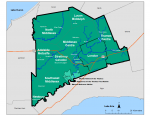Geography
Geography
The geographic area represented by the Middlesex-London Health Unit (Middlesex-London) is located in Southwestern Ontario and is bordered by the counties of Elgin, Oxford, Perth, Huron and Lambton and the Municipality of Chatham-Kent.
We acknowledge the history of the traditional territory on which this health unit stands. We also respect the longstanding relationships of the local First Nations groups of this land and place in Southwestern Ontario. First Nations’ traditional territories transcend public health unit boundaries. In particular, we acknowledge the traditional territory of the Anishinaabeg, Haudenosaunee, Attawandaran (Neutral), and Wendat peoples. This territory is covered by the Upper Canada Treaties.1
Middlesex-London covers an area of 3,317 square kilometres (Figure 1.1.1).
The Middlesex-London Health Unit includes the City of London and Middlesex County (including the County’s eight municipalities in order of geographic size: North Middlesex, Southwest Middlesex, Thames Centre, Strathroy-Caradoc, Middlesex Centre, Adelaide Metcalfe, Lucan Biddulph and the Village of Newbury) (Figure 1.1.1).
There are three First Nations communities in close proximity to this Health Unit: Chippewa of the Thames First Nation (Anishinaabe), Oneida Nation of the Thames (Haudenosaunee) and Munsee-Delaware Nation (Leni-Lunaape) (Figure 1.1.1).
The Middlesex-London administrative boundaries also coincide with a sub-region planning area, London Middlesex, of the Southwest Local Health Integration Network (SWLHIN).2
Interpretive Notes
The population of Ontario is served by 35 health units. The geographic area of each health unit is defined in the Health Protection and Promotion Act (R.R.O. 1990, Reg. 553, Schedule 20). These areas reflect the jurisdiction of each of the 35 boards of health.
The board of health recognizes the three First Nations’ inherent right to self-determination and sovereignty, while offering services to Indigenous Peoples that do not differentiate based on geographic location. This is in accordance with Jordan’s Principle which provides a child-first approach to meeting the needs of First Nations children in a culturally appropriate and efficient way; it requires that the government of initial contact with a child fund the health care and social services needs without delay and seek resolution later.3
Middlesex-London Board of Health works with the South West LHIN on population health assessment, joint planning for health services and population health initiatives for the Middlesex-London sub-region.4
How this Indicator was Calculated:
Boundary maps from the 2016 Census were used to create the administrative boundaries for the Middlesex-London Health Unit’s geographic boundaries.
Ontario Public Health Standards: Requirements for Programs, Services, and Accountability
Population Health Assessment and Surveillance Protocol, 2018
References:
- Ontario Federation of Labour Aboriginal Circle and Ontario Federation of Labour Aboriginal Persons Caucus. Traditional Territory Acknowledgements in Ontario [Internet]. Toronto ON: Ontario Federation of Labour 2017 [cited 2018 Nov 22]. Available from: www.ofl.ca/wp-content/uploads/2017.05.31-Traditional-Territory-Acknowledgement-in-Ont.pdf
- South West Local Health Integration Network. Sub-regions: Bringing local even closer to home [Internet]. London ON: South West Local Health Integration Network [cited 2018 Nov 27]. Available from: www.southwestlhin.on.ca/patientsfirst/Sub-regiongeographies.aspx
- Canadian Public Health Association. Jordan’s Principle and Public Health. [Internet]. Ottawa. ON: Canadian Public Health Association 2017 [cited 2018 Nov 22]. Available from: www.cpha.ca/sites/default/files/uploads/policy/positionstatements/jordan-positionstatement-e.pdf
- Population and Public Health Division, Ministry of Health and Long-Term Care. Board of Health and Local Health Integration Network Engagement Guideline, 2018. [Internet]. Toronto, ON: Queen's Printer for Ontario; 2018. Available from http://www.health.gov.on.ca/en/pro/programs/publichealth...
Last modified on: January 25, 2019
Jargon Explained
Middlesex-London
Middlesex-London, as referred to in this resource, is the geographic region served by the Middlesex-London Board of Health. It includes the residents of the City of London and the County of Middlesex. To the extent that the data sources permit, this report includes the urban Indigenous populations in Middlesex-London and the residents of the three First Nation’s communities in close proximity to this Health Unit: Chippewa of the Thames First Nation, Oneida Nation of the Thames and Munsee-Delaware Nation.
